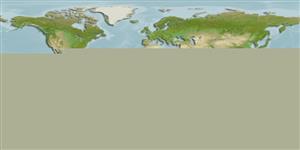Common names from other countries
>
Blenniiformes (Blennies) >
Blenniidae (Combtooth blennies) > Salariinae
Etymology: Praealticus: Latin, prae = in front of + Latin, altus, alticus = nutritious.
Environment: milieu / climate zone / depth range / distribution range
Ekologi
marina bottenlevande. Tropical
Western Pacific: South China Sea.
Size / Vikt / Age
Maturity: Lm ? range ? - ? cm
Max length : 9.0 cm TL hane/ej könsbestämd; (Ref. 90102)
Short description
Bestämningsnycklar | Morfologi | Morfometri
Taggstrålar i ryggfenan (totalt) : 12 - 14; Mjukstrålar i ryggfenan (totalt) : 16 - 20; Taggstrålar i analfenan: 2; Mjukstrålar i analfenan: 18 - 22. Greenish grey, white on abdomen, numerous dark vertical lines on cheek, snout, and lips, about 5 pairs of dark bars on side of body, outer part of soft dorsal fin with oblique yellow bands, and middle of caudal-fin base with blackish blotch/steak. Dorsal fin deeply notched; segmented caudal rays typically 13-14, branched middle 1-8; pinnately branched supraorbital tentacle; lacking nape cirri; posterior rim of anterior nostril with small cirrus (typically unbranched); upper and lower lip margin crenulate; males with occipital crest; last dorsal ray and caudal peduncle connected by membrane; elongate body, depth at anal-fin origin ca. 6.0-6.6 in SL. Maximum length 9 cm TL (Ref. 90102).
Facultative air-breathing (Ref. 126274); Adults inhabit rocky shores and intertidal zone (Ref. 90102). Oviparous. Eggs are demersal and adhesive (Ref. 205), and are attached to the substrate via a filamentous, adhesive pad or pedestal (Ref. 94114). Larvae are planktonic, often found in shallow, coastal waters (Ref. 94114).
Life cycle and mating behavior
Maturities | Reproduktion | Spawnings | Egg(s) | Fecundities | Larver
Oviparous, distinct pairing (Ref. 205).
Randall, J.E. and K.K.P. Lim (eds.), 2000. A checklist of the fishes of the South China Sea. Raffles Bull. Zool. Suppl. (8):569-667. (Ref. 36648)
IUCN Red List Status (Ref. 130435)
CITES (Ref. 128078)
Not Evaluated
Threat to humans
Harmless
Human uses
Verktyg
Special reports
Download XML
Internet-källor
Estimates based on models
Preferred temperature (Ref.
115969): 25.8 - 29.3, mean 28.7 (based on 1331 cells).
Phylogenetic diversity index (Ref.
82804): PD
50 = 0.5001 [Uniqueness, from 0.5 = low to 2.0 = high].
Bayesian length-weight: a=0.00741 (0.00335 - 0.01640), b=3.02 (2.83 - 3.21), in cm Total Length, based on LWR estimates for this (Sub)family-body shape (Ref.
93245).
Trofisk nivå (Ref.
69278): 2.0 ±0.00 se; based on food items.
Resiliens (Ref.
120179): Hög, lägsta populationsfördubblingstid mindre än 15 månader (Preliminary K or Fecundity.).
Fishing Vulnerability (Ref.
59153): Low vulnerability (10 of 100).
